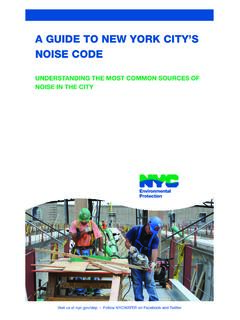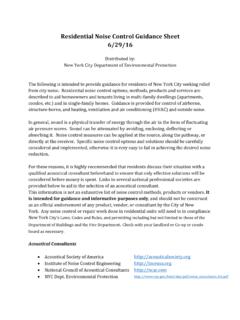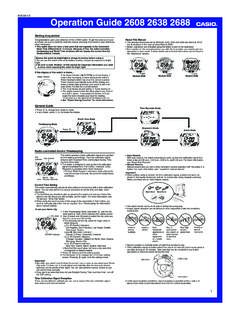Transcription of CAUSALITY AND ENDOGENEITY: PROBLEMS AND …
1 CAUSALITY AND endogeneity : PROBLEMS AND SOLUTIONS. John Antonakis Faculty of Business and Economics University of Lausanne Samuel Bendahan Faculty of Business and Economics University of Lausanne Philippe Jacquart The Wharton School University of Pennsylvania Rafael Lalive Faculty of Business and Economics University of Lausanne Reference : Antonakis, J., Bendahan, S., Jacquart, P., & Lalive, R. (2014). CAUSALITY and endogeneity : PROBLEMS and solutions. In Day (Ed.), The Oxford Handbook of Leadership and Organizations (pp. 93-117). New York: Oxford University Press. 1. Abstract Most leadership and management researchers ignore one key design and estimation problem rendering parameter estimates uninterpretable: endogeneity .
2 We discuss the problem of endogeneity in depth and explain conditions that engender it using examples grounded in the leadership literature. We show how consistent causal estimates can be derived from the randomized experiment, where endogeneity is eliminated by experimental design. We then review the reasons why estimates may become biased ( , inconsistent) in non-experimental designs and present a number of useful remedies for examining causal relations with non- experimental data. We write in intuitive terms using nontechnical language to make this chapter accessible to a large audience.
3 Author supplied-keywords: endogeneity , CAUSALITY , Randomized Experiments Quasi- Experimentation, Instrumental Variables, Common-Methods Bias. 2. Man is impelled to invent theories to account for what happens in the world. Unfortunately, he is not quite intelligent enough, in most cases, to find correct explanations. So that when he acts on his theories, he behaves very often like a lunatic.. Aldous Huxley (Texts and Pretexts, 1932, p. 270). Theory is the ultimate aim of science (Kerlinger & Lee, 2000). Contrary to the lay individuals described in Aldous Huxley's opening quote, scientists put their theories to the empirical test in order to determine whether or not the theories are plausible.
4 As stated by Murphy (1997, p. 4), the methods chosen should be appropriate to the research question and the inferences drawn should be consistent with what was actually attempted in [the] study . Given the importance of theory testing for understanding and predicting how the world works, the choice of research design and analysis method is of the utmost importance, particularly because research findings influence policy and practice. As we will explain in detail, the randomized experiment is the gold standard to identify and test causal relationships. However, be it for practical or ethical considerations, it may not always be possible to conduct randomized experiments (see Cook, Shadish, & Wong, 2008.)
5 Rubin, 2008). Although most researchers undoubtedly know that the randomized experiment is the method of choice to infer CAUSALITY , many researchers ignore two key issues: 1. experimental design is not the only method available to make valid causal inferences;. that is, there are other designs available to make valid causal claims, which do not require manipulation of the exogenous variables on the part of the researcher. 2. nonexperimental designs that do not address PROBLEMS of endogeneity are pretty much useless for understanding phenomena; that is, finding a relationship between an endogenous regressor x that has not been purged from endogeneity somehow and y does not help 3.
6 Leadership theory one bit! The way in which we state the above two points, particularly the second is, admittedly rather harsh and blunt; however, going through the chapter will make readers realize that what we have said is actually an understatement. To help research advance in leadership (and other social sciences) more researchers must join the effort to stomp-out endogeneity ; this problem is far bigger than we dared to imagine. We recently conducted a review of leadership studies suggesting that the conditions and designs that allow to uncover causal relationship with non-experimental data are not well understood by the majority of leadership researchers (Antonakis, Bendahan, Jacquart, & Lalive, 2010).
7 This problem is not isolated to the field of leadership. In fact, aside from the field of economics, which starting addressing this problem a couple of decades ago, many social-sciences disciplines face a similar situation (Bascle, 2008; Duncan, Magnusson, & Ludwig, 2004; Foster & McLanahan, 1996; Gennetian, Magnuson, & Morris, 2008; Halaby, 2004; Larcker & Rusticus, 2010; Shaver, 1998). For example, a recent review has found that less than 10% of the papers published in the top strategy journal ( , Strategic Management Journal) properly analyzed the non-experimental data they presented (Hamilton & Nickerson, 2003).
8 In our review, where we examined a random sample of 110 leadership papers published in top scientific journals, we found that researchers failed to correct between 66 % to 90 % of design and estimation conditions that threaten estimate validity (refer to Table 1 for a summary of the threats). We also found that 109 of the articles had at least one threat to validity and that 100 articles had three or more validity threats (which we discuss in more detail later). This sad state of affairs has to be changed because policy implications that stem from research that is incorrectly undertaken will be wrong.
9 [Table 1 here]. 4. When we refer to causal analysis of nonexperimental data, we are referring to designs that will produce coefficients that capture the magnitude of the true (causal) relationship rather than just an association or a correlation (which could be spurious). True estimates are called consistent. To say that an estimate is consistent suggests that it will converge to the true population parameter as sample size converges to infinity ( , asymptotically). The main threat to consistency is endogeneity ; much of what we will discuss in this chapter focuses on explaining what it is and how to deal with it.
10 If an estimate is inconsistent, it is purely and simply uninterpretable. A coefficient may appear to adequately reflect the hypothesized relationship for example, it is the right direction and the effect is highly significant but in presence of endogeneity it will be inconsistent and will not reflect the true population parameter. Reporting it is pretty much useless to help understand a phenomenon because the observed correlation may be far off from the true relation; that is, the true relation could be higher, lower, zero, or of a different sign from the observed association (correlation).



